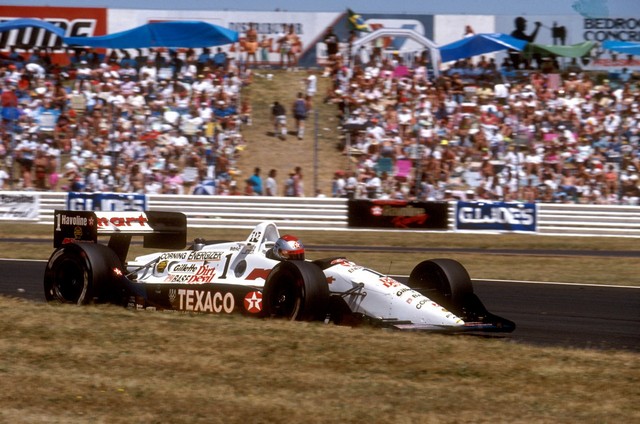By Peter M. DeLorenzo
Detroit. Now that the dust has settled from the Formula 1 Grand Prix opener in Australia, a few things can be said with a modicum of certainty. The cars are more aggressive looking with the wider tires, they're notably quicker, and judging by the overall performance of the Ferrari team and Vettel's win (see more in "The Line" -WG), it looks like there will be real competition for Mercedes this year. All very good things indeed.
But has enough changed with Formula 1? Or all that much when it comes right down to it? Not really, no. This isn't a knock on the new ownership group, because any meaningful changes will be much slower to bring about, and I get that. F1 has been doing things basically the same way for a long, long time, so shaking things up will only translate into a mild procession of differences here and there rather than a torrent of change. Maybe I will be surprised, but I seriously doubt it. Formula 1 is a giant ship of corporate enterprise and profitability, and turning this Leviathan will not be easy, or quick.
But there's one big thing missing, one that I believe should be addressed so that in a couple years' time we can revel in its wonderfulness, and that is the sound of the engines. Last fall, I wrote a column entitled "Bring Back The Scream," which generated a lot if interest and (mostly) positive comments. In it I said, "If you listen to the growing grumbles from the people who actually drive the machines in F1, they seem to be echoing each other in their comments. They want more power. They want the machines to be as difficult to drive as possible. And they want more noise, which all sounds perfectly reasonable to me."
In F1's corporate push - in sync with the participating engine manufacturers - to make the engines technically more in keeping with production efforts, they have completely lost the plot. People don't go to see an F1 race to revel in production engine technology. We can revel in that kind of mundane all we want on a daily basis. But when the effort is made in terms of time, money and scheduling to actually attend a Formula 1 Grand Prix, enthusiasts want to be wowed. And engines that are muted and uninspiring, no matter the technical aspects and prodigious power development, just don't cut it. This is supposed to be the pinnacle of the sport, not an apologist demonstration of relevant technology. That's why the FIA created Formula E, and that's where it should stay.
Changing the engine formula would be the one fundamental thing that the new F1 owners could do to demonstrate their willingness that this is not business as usual. In case you need a reminder of what "bring back the scream" really means, here's a clip of Ayrton Senna in his McLaren MP4/6-3.5-Liter V12 Honda in qualifying for the 1991 Australian Grand Prix.
I got into this discussion about bringing back the scream on Twitter yesterday in the aftermath of the race and Chris Dyson, the two-time IMSA/ALMS champion sports car racer, offered some interesting perspective as well. Chris said, "True, but the full fat turbo engines from 1986 did sound so wonderfully powerful and angry. *While they lasted!" And I agreed.
I remember watching practice for the 1986 Detroit Grand Prix on Saturday morning - this was on the old, gritty downtown circuit - and it was raining fairly hard. And only two drivers went out in the entire session, Eddie Cheever in his No. 16 Team Haas Lola THL2/Hart 415T, and Ayrton Senna in his No. 12 John Player Special Team Lotus Lotus 98T/Renault EF15B. Watching Senna grab that black Lotus by the scruff of the neck and masterfully control the on/off nature of the massive power in his Renault Turbo while blistering that nasty circuit in a downpour is etched in my memory forever, and I'll never forget it. You can get an idea of that circuit in this clip (not in the rain) here.
I should stress that my perspective here isn't based on a some sort of "everything was better back then" nostalgia play. When enthusiasts go to an F1 race or watch it on TV, they should be wowed. Not by the antiseptic orchestration and rote cadence of a typical F1 weekend, but by the sheer, gut-wrenching power and pure speed.
I'm not getting that right now. And I want it back.
And that's the High-Octane Truth for this week.
Editor's Note: Many of you have seen Peter's references over the years to the Hydrogen Electric Racing Federation (HERF), which he launched in 2007. For those of you who weren't following AE at the time, you can read two of HERF's press releases here and here. And for even more details (including a link to Peter's announcement speech), check out the HERF entry on Wikipedia here. -WG
Publisher's Note: As part of our continuing series celebrating the "Glory Days" of racing, we're proud to present another noteworthy image from the Ford Racing Archives. - PMD
 (Courtesy of the Ford Racing Archives)
(Courtesy of the Ford Racing Archives)
Portland, Oregon, June 21, 1992. Michael Andretti (No. 1 Newman Haas Racing Kmart/Texaco Havoline Lola/Ford-Cosworth XB V8) on his way to the win in the Budweiser/G.I. Joe's 200 CART race at Portland International Raceway. It was the first race win for the Ford-Cosworth XB V8 engine. Emerson Fittipaldi (No. 5 Roger Penske Racing Marlboro Penske/Chevrolet) was second and Al Unser Jr. (No. 3 Galles Kraco Racing Galmer/Chevrolet) finished third.